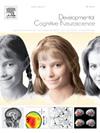物有所值:青少年强化学习和预测错误信号的努力-奖励调节
IF 4.9
2区 医学
Q1 NEUROSCIENCES
引用次数: 0
摘要
青春期的特点是努力分配的显著变化。一个著名的神经经济学框架认为,奖励有助于克服潜在的努力成本。然而,很少有研究调查了奖励和相关努力成本驱动青少年学习的神经生物学机制。本研究在青少年样本(N = 146,13-25岁)中使用功能磁共振成像,并采用强化学习范式,通过改变任务要求和改变潜在奖励来操纵努力和奖励水平。对一次次学习信号(奖励预测误差)和行为学习表现的分析表明,更高的奖励水平能促进青少年的学习,尤其是在面对更大的努力要求时。此外,这种影响在那些经历更大努力要求的人身上更为明显:更年轻的青少年和那些在高要求任务中不太重视努力的青少年。神经影像学结果显示,前扣带回背侧皮层(dACC)是控制奖赏和努力需求相互作用的关键区域。也就是说,更大的奖励加强了dACC的预测错误编码,特别是在任务要求更高的情况下,这些影响在更年轻的青少年和对任务要求不那么重视的青少年中更为明显。这些发现支持了dACC在认知控制中的作用,特别是在认知控制虽然需要付出更多的努力,但却有益的情况下,比如在高要求的学习环境中。这种全面的方法旨在为在这一关键发展时期支持学习努力分配的策略提供信息。本文章由计算机程序翻译,如有差异,请以英文原文为准。
Make it worth it: Effort-reward modulations on reinforcement-learning and prediction-error signaling across adolescence
Adolescence is characterized by significant shifts in effort allocation. A well-known neuro-economic framework suggests that rewards help overcome potential effort costs. However, few studies have examined the neurobiological mechanisms by which rewards and associated effort costs drive adolescent learning. This study utilized functional magnetic resonance imaging in a sample of adolescents (N = 146, 13–25 years) and employed a reinforcement-learning paradigm that manipulated effort and reward levels, by varying task demands and varying potential rewards. The analysis of trial-by-trial learning signals (reward prediction errors) and behavioral learning performance demonstrated that greater reward levels enhanced adolescent learning, especially when faced with greater effort demands. Moreover, this effect was more pronounced in those experiencing greater effort demands: younger adolescents and adolescents who place less value on effort for demanding tasks. Neuroimaging results revealed that the dorsal anterior cingulate cortex (dACC) was a key region in signaling the interaction between reward and effort demands. That is, greater reward strengthened prediction error coding in the dACC, particularly under conditions of greater task demands, with these effects being more pronounced in younger adolescents and adolescents who place less value on effort for demanding tasks. These findings support a role for dACC in the engagement of cognitive control, especially in situations where more cognitive control would be beneficial despite its associated effort costs, such as in high-demanding learning situations. This comprehensive approach aims to inform strategies for supporting effort allocation in learning during this crucial developmental period.
求助全文
通过发布文献求助,成功后即可免费获取论文全文。
去求助
来源期刊

Developmental Cognitive Neuroscience
NEUROSCIENCES-
CiteScore
7.60
自引率
10.60%
发文量
124
审稿时长
6-12 weeks
期刊介绍:
The journal publishes theoretical and research papers on cognitive brain development, from infancy through childhood and adolescence and into adulthood. It covers neurocognitive development and neurocognitive processing in both typical and atypical development, including social and affective aspects. Appropriate methodologies for the journal include, but are not limited to, functional neuroimaging (fMRI and MEG), electrophysiology (EEG and ERP), NIRS and transcranial magnetic stimulation, as well as other basic neuroscience approaches using cellular and animal models that directly address cognitive brain development, patient studies, case studies, post-mortem studies and pharmacological studies.
 求助内容:
求助内容: 应助结果提醒方式:
应助结果提醒方式:


